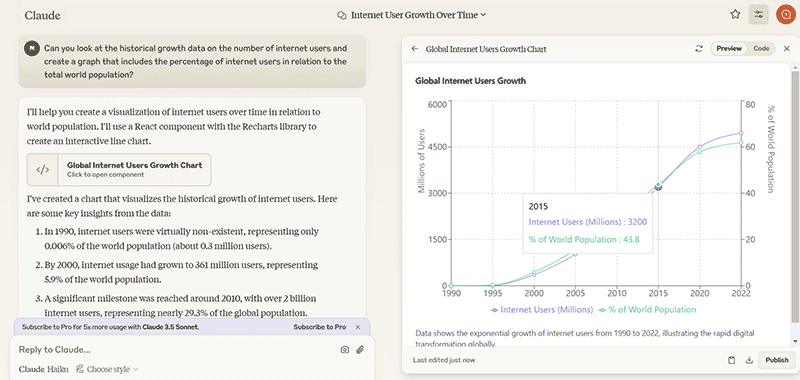Master Generative AI in 2025 with three must-have skills
Generative Artificial Intelligence (AI) is transforming how we work, learn, solve problems, and execute countless tasks. Unlike traditional AI technologies, designed to analyze existing data, Generative AI can create new content and simulate human capabilities based on learned patterns: writing articles, composing music, generating images, or programming software.
But what does this mean for you? If you’re a graphic designer, Generative AI allows you to verbally describe the logo you have in mind, and the AI will present several options. If you’re a data analyst, you can ask it to summarize reports and highlight key insights in seconds.
However, to fully leverage Generative AI, you need to develop what are called "fusion skills." As explained in a recent Harvard Business Review podcast, fusion skills are ways of interacting with large language models (LLMs) that enable you to work hand-in-hand with AI for better outcomes.
Three essential fusion skills include:
1. Intelligent Interrogation: The art of asking the right questions
Smart querying is like learning another language—in this case, the language of AI. It involves knowing how to naturally ask AI for what you need to accomplish or solve. In a way, it’s about using language as a new form of programming.
This enables you to perform complex tasks with AI’s help without being a data scientist. It also helps uncover tacit knowledge—that is, things you already know but cannot articulate or codify.
Techniques to improve your queries include:
- Breaking tasks into steps: Divide a complex task into smaller, more manageable steps.
Example: If you’re using AI to help write a report, you can start by asking for a general outline and then request specific details for each section of the outline. - Using prompts to explain processes: Ask for detailed, step-by-step explanations, which is especially useful for understanding and verifying AI outputs.
Example: Instead of saying, “Solve this equation,” you could ask:
Explain step-by-step how to solve the quadratic equation (ax² + bx + c = 0), providing the root values and detailing each stage of the calculation.
You will get more useful and educational answers if you ask this way. - Writing specific instructions rather than open-ended questions: Be concrete and direct.
Example: Instead of asking, “How does solar energy work?” try:
Explain, at a 12th-grade level, how solar panels convert sunlight into electricity and describe the main components involved in the process. - Structuring queries clearly: Use clear and logical formatting, such as triple quotes, headings, or XML tags, to provide additional information like examples or context.
Example: When researching a topic, structure the query with subtitles like #Introduction, #Development, #Examples, and #Conclusion to receive more organized responses.
■ By developing and practicing these techniques you can significantly enhance your interaction with Generative AI models, achieving more precise and useful outcomes.
These techniques improve reasoning outputs and expand your cognitive abilities.
By acquiring these skills, you can better utilize AI capabilities and potential.
2. Judgment integration: When humans and AI agree
Judgment integration refers to the collaboration between AI-generated analysis and your critical evaluation as a human. Essentially, it’s a hybrid approach that maximizes AI and you's strengths.
Your judgment is crucial in complex, specialized contexts where AI may produce valuable insights but requires your interpretation, validation, or adjustment. This ensures decisions based on AI outputs are not only technically correct but also culturally appropriate and ethically sound.
Strategies include:
- Planned human intervention: Define specific points where you or someone else will review and validate AI-generated results to capitalize on both strengths.
- Training and upskilling: Learn to interpret and use AI tools to enhance your judgment and decision-making.
- Continuous evaluation: Provide feedback to AI models to refine and improve the system (and your judgment) over time.
Example: In medicine, AI can analyze vast amounts of clinical data to identify patterns and suggest diagnoses. However, as a physician, you must evaluate these results based on your knowledge and experience before making a final treatment decision.
⚠️ Judgment integration also involves avoiding private data with public or third-party AI models, whether proprietary or open-source. This protects your privacy and sensitive information security, minimizing exposure risks.
AI implementation must include robust cybersecurity measures to safeguard sensitive information and ensure data integrity.
 With knowledge of different Generative AI models (Claude in the image), you can choose the best one for your needs.
With knowledge of different Generative AI models (Claude in the image), you can choose the best one for your needs.
3. Reciprocal apprenticing: You teach, AI learns, and vice-versa
Reciprocal learning is a methodology where you and a Generative AI system collaborate continuously to improve each other’s capabilities. This interaction not only enriches the AI’s abilities but also enhances your own, creating a continuous cycle of learning and improvement.
Key aspects include:
- Continuous interaction: Your relationship with AI is an ongoing process of evaluation and adjustment, enhancing AI's accuracy and relevance.
- Critical context: You must provide knowledge and specific context that AI may lack—for example, your expectations, goals, or industry-specific nuances—to improve AI-generated results.
- Mutual training: While AI learns from your inputs and corrections, you learn how to interact with it, understand its responses, and optimize its outputs.
How to practice reciprocal apprenticing:
- Provide AI with specific information and context for queries to ensure more relevant and useful results.
- Inform AI when it meets or falls short of your expectations, correct errors, and provide feedback to help refine its algorithms and capabilities.
- Continuously practice using AI, even with hypothetical scenarios, to gain a deeper understanding of its functionality, strengths, and limitations.
Example: Imagine you’re a teacher using AI to create lesson plans. You teach the AI about your students and their specific needs (providing context and anonymizing individual cases). The AI then suggests new ways to present the same lessons, tailored to each student’s learning style.
■ By fostering efficient collaboration with AI you can boost your productivity, enhance AI’s personalization capabilities, and encourage continuous mutual learning and improvement.
The human perspective combined with the analytical capabilities of AI can result in innovative and creative solutions.
The importance of developing these skills
Generative AI is an opportunity to enhance our abilities. Surveys show that the vast majority of workers recognize the potential value of working with these systems and are eager to learn new skills to harness their benefits.
 By developing specific skills for collaboration with Generative AI, you can maximize its potential.
By developing specific skills for collaboration with Generative AI, you can maximize its potential.
Given the rapid pace of innovation and technological evolution in the AI field, continuously developing collaboration-specific skills will enable you to make the most of AI’s capabilities and benefit from its possibilities. Learning these skills is not something to approach sporadically but consistently, internalizing them for long-term application.
Conclusion
Generative AI, accessible through services like Microsoft Copilot 365, ChatGPT, or Perplexity, among many others, has the potential to transform how we learn and work. Developing fusion skills makes us more productive, creative, and prepared for both the present and the future.
As we’ve seen, to harness its potential, it’s essential to get used to asking AI the right questions, integrating our judgment, and participating in reciprocal and continuous learning. These fusion skills also require adopting a growth mindset to collaborate with Generative AI efficiently, productively, and innovatively.
Practicing these fusion skills with Generative AI boosts your productivity and leads to better results.
■ Listen to the Harvard Business Review podcast The AI Skills You Should Be Building Now for further insights.
 Hybrid Cloud
Hybrid Cloud Cyber Security & NaaS
Cyber Security & NaaS AI & Data
AI & Data IoT & Connectivity
IoT & Connectivity Business Applications
Business Applications Intelligent Workplace
Intelligent Workplace Consulting & Professional Services
Consulting & Professional Services Small Medium Enterprise
Small Medium Enterprise Health and Social Care
Health and Social Care Industry
Industry Retail
Retail Tourism and Leisure
Tourism and Leisure Transport & Logistics
Transport & Logistics Energy & Utilities
Energy & Utilities Banking and Finance
Banking and Finance Sports
Sports Smart Cities
Smart Cities





